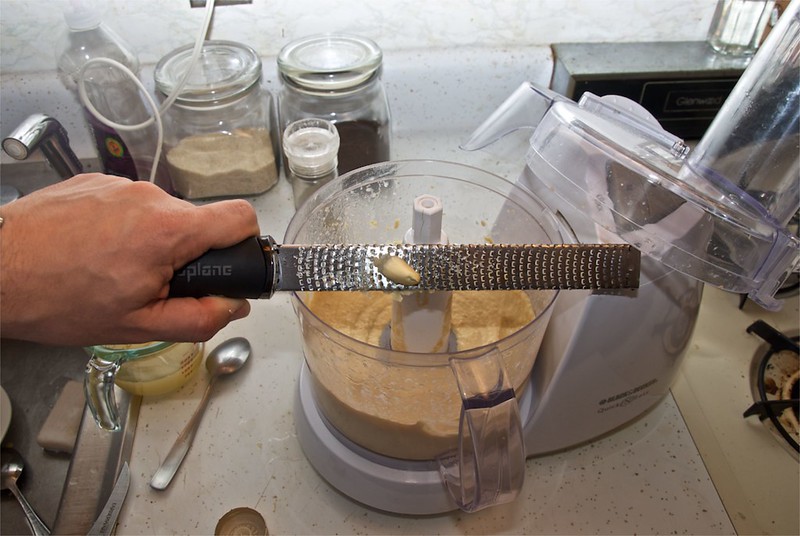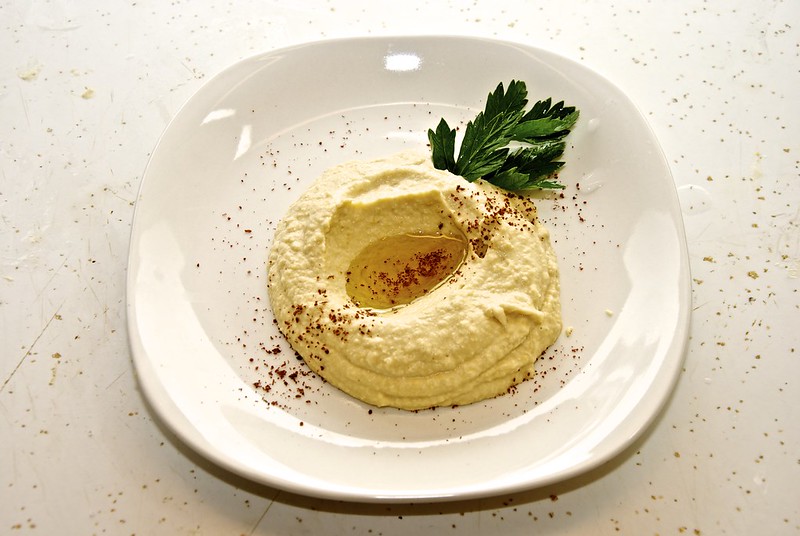
Greek restaurants across the USA had to adapt and adjust their menu and recipes. This usually happens with in three ways: i) the adaptation of classic recipes to whatever ingredients are available ii) the adaptation to the taste palette of the locals and iii) the adoption of dishes from other countries just because the locals seem to like them. Actually one of the most classic dishes, the poster child of the Greek food, the gyro sandwich originated in its final form in New York by Greek food track vendors out of necessity to battle tacos and shawarma as a fast food alternative. In the restaurant scenery, one of the Greek adopted dishes was, and still is, the hummus.
Yes! The hummus, a staple dish in every Greek restaurant, is not Greek, is not based on Greek food, and is not even known in Greece. Hummus is the mashed legumes that are mixed with tahini, olive oil and flavorings like herbs and spices. Although hummus is not Greek, legumes have been part of the Greek diet since the ancient years. So much actually that Greeks even had a semi-god that was the protector of the legumes and beans called Kyamites. And although hummus is unfamiliar to Greeks, there are similar dishes much-loved and appreciated in Greek culture, fava (featured here), made not with fava beans but yellow spit peas, and koukofava made with fava beans.
Dishes like that make perfect sense. Legumes are packed with energy provided by the polysaccharides, vitamins, minerals, fibers and are rich in proteins and essential amino acids. When combined with fat, either olive oil or tahini, they become one of the most complete meals anyone can have. Lastly legumes themselves in the dry state last for ever, never spoil and are easily cultivated. So it should be no surprise the development of dishes like this. Now it is mostly considered a dip, served with pita or veggies and the average grocery store has at least 5 variations, garlic, red pepper, chili etc. So many actually they almost convinced us that it one item that you only buy at the store. It gives you the impression that it is impossible to make it at home. Well not any more! It is not only easy to make at home, but since it is a legume based dishes it is almost like refrigerator velcro. The hummus recipe given here can be used to mix in, cheese, bacon, sauté mushrooms, roasted peppers or pretty much any flavor you like. No… Chocolate is not a good option…

For this recipe we will use:
- 1 can of chickpeas, or garbanzo bean (same thing really)
- 2 tbsp of tahini, the ground sesame seeds stable item in middle eastern diet
- Olive oil
- Garlic
- Lemon (not shown cause I don’t have lemon)
- Cumin
- Sumac*
- Parsley
- Salt
- Black Pepper
I know there is one unfamiliar and strange ingredient in the list of items. Sumac. Sumac is the ground up dried fruits of a middle eastern plant. Sumac was used as lemon, before the lemon, since it can add acidity to the dishes. It is naturally dark red, and it appears very similar to paprika. However, it is not paprika and it certainly does not taste like one. You don’t really need it, but it does suit well the traditional hummus recipe.
I know canned chick peas?! Yes canned. You can soak overnight, boil and drain a pound of them, but then it is not going to be easy, would it?! Just suck it up and go with the canned.

Open the can.

Strain and keep the liquid. We will need later it to adjust the texture.

Add the peas in the bowl of the food processor. Just do me a favor and make sure you have the blades installed and the whole assembly is sitting on the food processor, I forgot to do that, so I had to empty the bowl assemble it and add the chick peas again… Note that you can also use a blender as well or a stick blender if you don’t have a food processor. Or if you are a fun of manual labor use a mortal and pestle.

Follow that with 2 tbsps of tahini. They are actual hipping table-spoon (like soup spoon) of tahini. The more the better. It is an emulsifier and makes for a smoother texture.

Follow that with some olive oil. As much or as little as you want. You can also add more tahini and skip the oil all together.

Salt and pepper.

A few drops of lemon (ok, lime I have no lemon), just to brighten up the flavors.

And hit the pulse button. Let it blend, let it blend.

Now is the point to check the consistency of the hummus and adjust it. Hummus has to be creamy, yield easy to the fork or the dipping items, but it should also be able to sustain the shape that acquires without oozing or running.

Once the consistency is at the right level, add the garlic. Adding the garlic whole is not working in my food processor. The Food processors seem to always miss garlic leaving it in uneven chunks. But this is just me, when you make it your self just do it the way you want.

Serving is even easier. 1) Add it on the plate.

2) Make a little dimple.

3) Fill it with olive oil.

4) And sprinkle some of the sumac.

5) Finally decorate with a few leaves of parsley. We use parsley as decoration, but in middle eastern countries parsley was used as salad, so be daring add plenty of leaves when you try your hummus. And also try to enjoy it as a full meal. Don’t just use it to mask the ugly taste of veggies.
Printable Recipe Card
This dish is a staple at the middle eastern countries, but in the USA it has acquire a more Mediterranean dish, considered staple in greek restaurants.
Ingredients
-
1 can of chickpeas, or garbanzo bean (same thing really)
-
2 tbsp of tahini, the ground sesame seeds stable item in middle eastern diet
-
3 tbsp Olive oil
-
1 clove of garlic
-
Juice of 1 lemon (not shown cause I don’t have lemon)
-
1 tsp Cumin
-
1/4 tsp paprika (or sumac for authenticity)
-
4 Parsley leaves
-
Salt
-
Black Pepper
Directions
- Drain the chickpeas and keep the liquid.
- Mix the chickpeas, the tahini, the lemon juice, the olive oil, the cumin and the garlic.
- Blend until smooth.
- Use the reserved chickpeas liquid to bring it to the desired consistency.
- Adjust seasoning.
- Serve and decorate with the parsley and the sumac.











